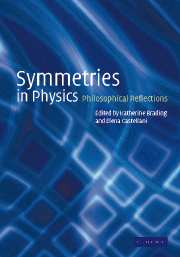Book contents
- Frontmatter
- Contents
- List of contributors
- Preface
- Copyright acknowledgements
- 1 Introduction
- Part I Continuous symmetries
- Part II Discrete symmetries
- Part III Symmetry breaking
- 17 Classic texts: extracts from Curie and Weyl
- 18 Cross fertilization in theoretical physics: the case of condensed matter and particle physics
- 19 On the meaning of symmetry breaking
- 20 Rough guide to spontaneous symmetry breaking
- 21 Spontaneous symmetry breaking: theoretical arguments and philosophical problems
- Part IV General interpretative issues
- Index
19 - On the meaning of symmetry breaking
Published online by Cambridge University Press: 08 October 2009
- Frontmatter
- Contents
- List of contributors
- Preface
- Copyright acknowledgements
- 1 Introduction
- Part I Continuous symmetries
- Part II Discrete symmetries
- Part III Symmetry breaking
- 17 Classic texts: extracts from Curie and Weyl
- 18 Cross fertilization in theoretical physics: the case of condensed matter and particle physics
- 19 On the meaning of symmetry breaking
- 20 Rough guide to spontaneous symmetry breaking
- 21 Spontaneous symmetry breaking: theoretical arguments and philosophical problems
- Part IV General interpretative issues
- Index
Summary
Symmetries can be attributed to physical states or to physical laws. The focus of this volume is on the symmetries of physical laws, that is the physical symmetries postulated by means of invariance principles. Accordingly, the focus of this review paper is on symmetry breaking in the case of physical laws. In this case, there are two different forms of symmetry breaking – ‘explicit’ and ‘spontaneous’ – the spontaneous symmetry-breaking case being the more interesting from a physical as well as a philosophical point of view.
After some general preliminary remarks on symmetry breaking, we start by examining how symmetry breaking was first considered in the literature, and then turn to the main subject of this paper, that is the physical and philosophical meaning of symmetry breaking of the laws of nature.
Preliminaries – I
A symmetry can be exact, approximate, or broken. Exact means unconditionally valid; approximate means valid under certain conditions; broken can mean different things, depending on the object considered and its context.
Our concern here is the breaking of physical symmetries. In physics, symmetry properties may be attributed to physical laws (equations) or to physical objects/phenomena (solutions). As the contributions to this volume clearly show, the two cases must be distinguished when considering the meaning and functions of physical symmetries and, accordingly, of their breaking.
- Type
- Chapter
- Information
- Symmetries in PhysicsPhilosophical Reflections, pp. 321 - 334Publisher: Cambridge University PressPrint publication year: 2003
- 12
- Cited by



